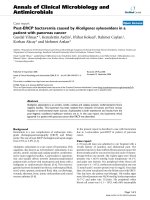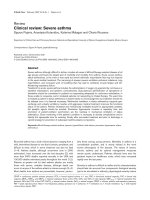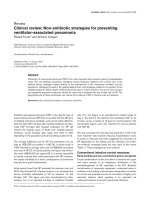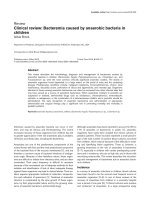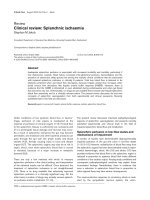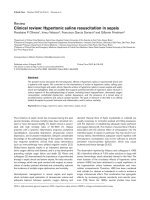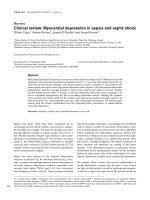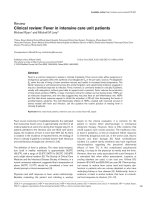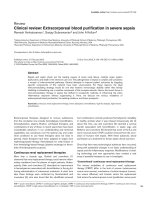Báo cáo y học: "Clinical review: Bacteremia caused by anaerobic bacteria in children" pdf
Bạn đang xem bản rút gọn của tài liệu. Xem và tải ngay bản đầy đủ của tài liệu tại đây (60.26 KB, 7 trang )
Available online />Infections caused by anaerobic bacteria can occur in chil-
dren, and may be serious and life-threatening. The recent
increased recovery of these organisms from children has led
to greater appreciation of the role anaerobes play in pediatric
infections at all body sites, including the bacteremia.
Anaerobes are one of the predominant components of the
normal human skin flora and the most predominant component
of the bacterial flora of the mucous membranes [1], and are
therefore a common cause of bacterial infections of endoge-
nous origin. Because of their fastidious nature, these organ-
isms are difficult to isolate from infectious sites, and are often
overlooked. Their exact frequency is difficult to ascertain
because of the inconsistent use of adequate methods for their
isolation and identification. A lack of direct adequate therapy
against these organisms may lead to clinical failures. Their iso-
lation requires appropriate methods of collection, transporta-
tion and cultivation of specimens [1]. Treatment of anaerobic
infection is complicated by the slow growth of these organ-
isms, by their polymicrobial nature and by the growing resis-
tance of anaerobic bacteria to antimicrobial drugs.
Although anaerobes have been reported to account for 8% to
11% of episodes of bacteremia in adults [1], anaerobic
organisms have rarely been isolated from blood cultures of
pediatric patients. These microbes represent a small percent-
age of the total number of positive blood cultures recovered
from children, which may be because of the difficulty in isolat-
ing and identifying these organisms. There is, however, a
growing awareness of the role of anaerobes in bacteremia
[2–7], especially in children with certain predisposing condi-
tions and in newborns, who are at high risk, and in those with
necrotizing enterocolitis. This review describes the microbiol-
ogy and management of bacteremia due to anaerobic bacte-
ria in children.
Incidence
In a survey of anaerobic infections in children, blood cultures
have been found to be the second most frequent source of
anaerobic organisms [2–4]. In one of these reviews of the
recovery of anaerobes from children in a university hospital
over a period of one year [5], 13 blood cultures were positive
and contained 14 anaerobes. In a large prospective study
Review
Clinical review: Bacteremia caused by anaerobic bacteria in
children
Itzhak Brook
Department of Pediatrics, Georgetown University School of Medicine, Washington DC, USA
Correspondence: Itzhak Brook,
Published online: 9 May 2002 Critical Care 2002, 6:205-211
© 2002 BioMed Central Ltd (Print ISSN 1364-8535; Online ISSN 1466-609X)
Abstract
This review describes the microbiology, diagnosis and management of bacteremia caused by
anaerobic bacteria in children. Bacteroides fragilis, Peptostreptococcus sp., Clostridium sp., and
Fusobacterium sp. were the most common clinically significant anaerobic isolates. The strains of
anaerobic organisms found depended, to a large extent, on the portal of entry and the underlying
disease. Predisposing conditions include: malignant neoplasms, immunodeficiencies, chronic renal
insufficiency, decubitus ulcers, perforation of viscus and appendicitis, and neonatal age. Organisms
identical to those causing anaerobic bacteremia can often be recovered from other infected sites that
may have served as a source of persistent bacteremia. When anaerobes resistant to penicillin are
suspected or isolated, antimicrobial drugs such as clindamycin, chloramphenicol, metronidazole,
cefoxitin, a carbapenem, or the combination of a beta-lactamase inhibitor and a penicillin should be
administered. The early recognition of anaerobic bacteremia and administration of appropriate
antimicrobial and surgical therapy play a significant role in preventing mortality and morbidity in
pediatric patients.
Keywords anaerobic bacteria, bacteremia, children, Bacteroides fragilis, Peptostreptoccus sp., Clostridium sp.
Critical Care June 2002 Vol 6 No 3 Brook
lasting a year, only 0.3% of blood cultures contained anaerobic
bacteria that were involved in the pathogenesis of the patient’s
disease [4]. In contrast, pathogenic aerobes were recovered
from 9% of the cultures tested during that period. Anaerobes
accounted for 5.8% of all bacteremic episodes (8.7% in the
newborn period and 4.8% in children over 1 year of age).
Notably, 10% of the newborns with clinical bacteremia had
only anaerobes recovered from their blood cultures.
Zaidi et al. [8], reviewed the use of anaerobic blood cultures
for children and noted that 15 (2.1%) of 723 cases of bac-
teremia were caused by strict anaerobes and they concluded
that use of the entire volume of blood drawn should be
reserved for aerobic cultures. Recent studies have suggested
that there has been a decline in the incidence of anaerobic
bacteremia. Some authors [9–13] have speculated that this
might be as a result of the use of bowel preparations prior to
abdominal surgery and the more routine use of antibiotics
active against anaerobes.
Microbiology
Anaerobic bacteremia has rarely been described in pediatric
patients [13,14]. Sanders and Stevenson [7] in a review of
the literature in 1968 summarized 11 cases of Bacteroides
bacteremias in children. In one study, anaerobic organisms
were recovered from 6 of 34 children who required general
anesthesia and nasotracheal intubation for dental repair [15].
Another study documented bacteremia in 28 children who
were undergoing dental manipulations [16]. Among the 28
isolates recovered, 21 were anaerobes (Propionibacterium
sp., nine; Veillonella alcalescens, five; Prevotella melanino-
genica, three; Peptostreptococcus sp., two; and Eubacterium
sp. and Fusobacterium sp., one each).
Brook et al. [5] reviewed their experience in recovery of
anaerobes in the blood over a 12-month period. A total of 13
blood cultures were positive and contained 14 anaerobic
agents: five were Bacteroides fragilis, three others were Bac-
teroides sp., two were Fusobacterium sp., three were Propi-
onibacterium sp., and one was Peptostreptococcus sp. In
one instance two organisms were isolated from a blood
culture: Peptostreptococcus sp. and Fusobacterium sp.
Dunkle et al. [3] recovered 14 anaerobes from blood cultures
over a 1-year study. The dominant anaerobes recovered were
Clostridium sp. (four), Fusobacterium nucleatus (three
species), Gram-positive cocci (three species), and B. fragilis
(two species). Although 27 isolates of Propionibacterium
acnes were recovered, only three were associated with clini-
cal infection.
Thirmuoothi et al. [4] reviewed their experience over a period
of 18 months, and reported 35 anaerobic isolates from 34
blood cultures. The predominant isolates were four each of
Gram-positive cocci and Bacteroides sp. and two isolates
each of Fusobacterium sp., Bifidobacterium sp., and
Clostridium sp. Although Propionibacterium sp. were recov-
ered in 18 instances, there was no apparent relationship
between their recovery from the blood and the 18 patients’
clinical illness.
Brook and colleagues [17] summarized their experience in
the diagnosis of anaerobic bacteremia noted in 28 children.
Twenty-nine anaerobic isolates were recovered from 28
patients ranging in age from 1 week to 15 years. Of these iso-
lates, 14 were Bacteroides sp. (11 of which belonged to the
B. fragilis group); four were Clostridium sp.; four were anaer-
obic Gram-positive cocci; four were P. acnes; and three were
Fusobacterium sp. Although the predominant isolate from
blood cultures (56–65%) is P. acnes [2,3], a normal inhabi-
tant of the skin, many of these isolates may reflect contamina-
tion of the blood cultures by the skin flora. Propionibacterium
acnes can cause bacteremia, however, especially in associa-
tion with shunt infections [18]. All of the patients with
P. acnes bacteremia included in the study by Brook et al. [17]
had clinical infection, and all but one responded to antimicro-
bial therapy. Furthermore, two patients had meningitis caused
by this organism after installation of cardiovascular shunts.
An important aspect of anaerobic bacteremia is that anaer-
obes frequently are present in cases of polymicrobial bac-
teremia [1], reflecting the fact that localized anaerobic
infections are usually polymicrobial. Polymicrobial bacteremia
involving anaerobic bacteria were reported by several
authors. Frommell and Todd [19] reported 56 children with
bacteremia with multiple bacterial isolates. Five anaerobes
were isolated: two Bacteroides sp., two Peptostreptococci
and one Clostridium perfringens. Rosenfeld and Jameson
[20] reported a 15-year-old child with polymicrobial bac-
teremia involving seven isolates (including four Bacteroides
sp. and an anaerobic cocci) associated with pharyngotonsilli-
tis. Seidenfeld et al. [21] reported an adolescent with a fatal
bacteremia caused by Fusobacterium necrophorum and Pep-
tostreptococcus sp. associated with peritonsillar abscess.
Givner et al. [22] recovered Bacteroides capillosus with
Corynebacterium hemolyticum from the blood of a child with
primary Epstein–Barr virus infection who developed sinusitis.
Caya and Truant summarized 65 cases of non-infant pediatric
clostridial bacteremia [23]. The predominant isolates were
Clostridium septicum (25 isolates), Clostridium perfringens
(21 isolates) and Clostridium tertium (six isolates). Of the 63
children analyzed, 29 (46%) survived their episode of
clostridial bacteremia. Three clinical indices were shown to
have a statistically significant negative impact on survival:
hypotension, hemolysis and lack of antibiotic therapy. Of the
36 patients with known underlying neoplastic disease, 27
had acute leukemia, five had sarcoma, three had a malignant
lymphoproliferative disorder and one had glioblastoma multi-
forme. Of the 23 patients with no underlying neoplasia, three
of them had cyclic neutropenia, two were in sickle cell
disease crisis, two had neutropenia associated with aplastic
anemia, and one was mildly immunocompromised as a result
of renal transplantation.
Brook reported the microbiology of 101 specimens obtained
from 95 children with malignancy [24]. A total of 17 patients
had bacteremia. Four had Escherichia coli, in one instance
mixed with B. fragilis. Bacteroides fragilis group isolates were
recovered in three instances (two in patients with leukemia
who had a perirectal abscess), Staphylococcus aureus in
three patients, Clostridium spp. in two (one C. perfringens
and one C. septicum) and two Proteus spp.
Brook summarized clinical and microbiological data of 296
adults with anaerobic bacteremia [25]. Anaerobes were iso-
lated with aerobic or facultative bacteremia in 23 instances.
The B. fragilis group accounted for 148 (70%) of 212 iso-
lates of anaerobic Gram-negative bacilli. Bacteroides fragilis
accounted for 78% and B. thetaiotaomicron for 14%. Among
other species, there were 20 (6%) Fusobacterium organisms,
63 (18%) Clostridium isolates, and 53 (15%) anaerobic
cocci. Seventy-five patients died: 40 of these had B. fragilis
group isolates (including B. fragilis, 28, and B. thetaiotaomi-
cron, 8) and 21 had Clostridium organisms isolated.
Pathogenesis
Portal of entry
Anaerobic bacteremia is almost invariably secondary to a
focal primary infection. As reported for adults [13], the strain
of anaerobic organisms recovered depended to a large extent
on the portal of entry and the underlying disease. Bacteroides
fragilis is the most frequent anaerobic isolate [13, 23–28]
and, with other members of the B. fragilis group species,
accounts for 36–64% of anaerobic blood isolates. Bac-
teroides thetaiotaomicron is the second most common
member of the group to be isolated from blood. Clostridia,
especially C. perfringens, and peptostreptococci are also fre-
quently isolated from blood. The gastrointestinal tract
accounted for half of the anaerobic bacteremias and the
female genital tract was the source of 20% of these bac-
teremias [13, 27–30].
Brook [25] noted in adults that the gastrointestinal tract was
the principal source of B. fragilis and clostridial bacteremias
and that the female genital tract was the principal source of
peptostreptococcal and fusobacterial bacteremias. Redondo
et al. [30] reported that bacteremias caused by the B. fragilis
group of organisms originated from: the gastrointestinal tract
(69% of bacteremias); soft-tissue wound infections (16%);
the female genitourinary tract (5%); and lung infections (4%).
Fainstein et al. [31] found bacteremia caused by B. fragilis to
be common in patients with genitourinary and gynecological
tumors, acute leukemia, and gastrointestinal malignancies.
The probable portals of entry for the blood culture isolates in
the 28 children studied by Brook and associates [17] were:
the gastrointestinal (GI) tract (13 patients), the respiratory
tract (ear, sinus, and oropharynx, seven), the lower respiratory
tract (three), cardiovascular shunts and neurologic shunts
(three), and skin and soft tissue (three). When the GI tract
was the probable portal of entry, Bacteroides sp. (eight iso-
lates, including five B. fragilis) and Clostridium sp. (four iso-
lates) were the organisms most frequently recovered from
blood. The predominant anaerobic organisms recovered in
association with infections of the ear, sinus and oropharynx
were Peptostreptococcus sp. (from four patients) and F.
nucleatum (from two patients). Propionibacterium acnes was
grown in cultures taken from four patients, three of whom had
artificial cardiac valves or ventriculoatrial shunts. Two of these
patients also were initially observed to have meningitis
caused by a similar organism. All lower respiratory tract infec-
tions that served as a probable source of bacteremia were
caused by isolates belonging to the B. fragilis group.
No obvious focus of infection was noted in six patients; inter-
estingly, however, all of these patients had some GI problem
that might have served as a source of the bacteremia. Fur-
thermore, four of these patients had bacteremia caused by
Clostridium species.
These findings therefore support studies of adults [13,32,33]
and children [6,14] that report that Bacteroides species,
including the B. fragilis group, were the predominant isolates
from patients in whom the GI tract was the probable portal of
entry. As summarized by Sanders and Stevenson [7],
however, other anaerobic Gram-negative bacilli caused bac-
teremia in children with otitis media and abscesses.
The ear, sinus, and oropharynx were found to be possible
portals of entry that predisposed patients to bacteremia with
Peptostreptococcus sp. and Fusobacterium sp. This is not
surprising because these organisms are part of the normal
flora of these anatomic sites and can be involved in local
infections [27].
Three newborns developed bacteremia in conjunction with
pneumonia with organisms belonging to the B. fragilis group
[17]. This has also been noted before in newborns [5] and
adults [1]. Although Bacteroides accounted for the majority
of the episodes of bacteremia in this study, other studies
have shown relatively infrequent isolation of these organisms
from children [1], except during the neonatal period [5].
An association between surgical procedures and anaerobic
septicemia was recently reported. Pass and Waldo [34]
observed anaerobic bacteremia in two infants following
suprapubic bladder aspiration. Bacteroides fragilis was iso-
lated in one instance and in another instance was mixed with
Veillonella alcalescens. An accidental bowel perforation was
the assumed etiology of these infections. Kasik et al. [35]
observed sepsis and meningitis caused by E. coli and Bac-
teroides sp. after anal dilatation. Fusobacterium mortiferum
was also recovered in the blood.
Available online />Fisher et al. [36] described bacteremia caused by B. fragilis
in four of 75 children after elective appendectomy in renal
transplant recipients. The bacteremia was associated with
profound lymphopenia. Fusobacterial infection generally is
associated with otolaryngological processes. Seidenfeld et
al. [21] reported five patients, four of whom were children,
who developed F. necrophorum septicemia following oropha-
ryngeal infection. Septicemia caused by Streptococcus mor-
billorum was reported by Rushton to have complicated
herpetic pharyngitis [37].
Predisposing factors
Bacteroides fragilis, anaerobic Gram-positive cocci, and
Fusobacterium sp. were the clinically significant anaerobic
organisms most commonly isolated from blood cultures in
three recent studies [2–4]. Most of the patients described in
these studies were either newborns or were over 6 weeks of
age and suffered from chronic debilitating disorders such as
malignant neoplasms, immunodeficiencies, chronic renal
insufficiency, or decubitus ulcers and carried a poor progno-
sis. Bacteroides sp. were also isolated frequently after perfo-
ration of viscus and appendicitis [38,39].
Clostridium sp. may complicate leukemias. Caya et al. [40]
reported 11 children with leukemia who presented with
sepsis caused by Clostridium septicum (seven children), C.
perfringens (two children), and Clostridium sp. (two children).
None of these children survived the sepsis, which was char-
acterized by thrombocytopenia, gastrointestinal lesions, and
neutropenia.
Infectious mononucleosis can also predispose to anaerobic
bacteremia. Dagan and Powell [41] observed three patients
who developed postanginal anaerobic sepsis following
Epstein–Barr virus infection. All three had Fusobacterium
species isolated (two were F. necrophorum) and in one case
a Peptostreptococcus was also recovered.
Predisposing factors to anaerobic bacteremia in adults
include malignant neoplasms [42,43], hematologic disorders
[44], transplantation of organs [45], recent gastrointestinal or
obstetric gynecologic surgery [43,44,46], intestinal obstruc-
tion [47], diabetes mellitus [43], post-splenectomy [42], use
of cytotoxic agents or corticosteroids [43], and use of pro-
phylactic antimicrobial agents for bowel preparation prior to
surgery [43,46].
Predisposing conditions were noted also in one study of
pediatric patients [17]. Two patients had malignant neo-
plasms, two suffered from hematologic abnormalities, and
one had an immune deficiency. Interestingly, 82% of the bac-
teremias in this series of patients [17] occurred in children
who had no immunosuppression or malignant neoplasms.
This is in contrast to another study [14] in which anaerobic
bacteremia occurred more frequently in children with these
predisposing factors. Dental or oral surgery can also predis-
pose to anaerobic bacteremia in adults and children
[13,15,16].
Diagnosis and clinical features
The clinical features of anaerobic bacteremia are not much
different from those associated with other types of bac-
teremia in children; however, a relatively longer period is gen-
erally needed before an etiologic diagnosis can be made.
This can be a result of the smaller volume of blood drawn
from children for culture inoculation and the longer time
needed for growth and identification of anaerobic organisms.
Diagnosis should include detection of the primary infection.
The clinical presentation of anaerobic bacteremia relates, in
part, to the nature of the primary infection, which will typically
include fever, chills and leukocytosis. Anemia, shock and
intravascular coagulation may also be present. Bacteroides
bacteremia is generally characterized by thrombophlebitis,
metastatic infection, hyperbilirubinemia and a high mortality
rate (up to 50%). Clostridium perfringens bacteremia may
have a most dramatic clinical picture, consisting of hemolytic
anemia, hemoglobinemia, hemoglobinuria, disseminated
intravascular coagulation, bleeding tendency, bronze-colored
skin, hyperbilirubinemia, shock, oliguria and anemia.
Clostridial bacteria may, however, be transient and inconse-
quential. However, C. septicum infection may be a marker for
a silent colonic or rectal malignancy [40].
Blood culture supporting the growth of anaerobic bacteria
should be used routinely in all patients. In addition to support-
ing the growth of strict anaerobes, blood cultures also facili-
tate the growth of many facultative anaerobes. Some cases of
culture-negative endocarditis, fever and systemic toxicity with
negative blood cultures are undoubtedly cases of anaerobic
bacteremia that elude detection because of inadequate
methodology.
Management
Because of the high mortality rate (15–35%) associated with
anaerobic bacteremia, it is imperative to establish early effec-
tive therapy. Prolonged therapy with antimicrobial agents
apparently is adequate for most patients. However, any
source of infection, such as an abscess, should be surgically
drained. The average duration of therapy in the patients who
recovered in one study [17] was 20 days (range, 7–72 days),
and the duration of therapy was related to the presence and
severity of other infectious sites and complications. Therapy
was longest in the treatment of bacteraemia associated with
meningitis, wound abscess, sinusitis and empyema. When
anaerobes resistant to penicillin, such as the B. fragilis group,
are suspected or isolated, antimicrobial drugs, such as clin-
damycin, chloramphenicol, metronidazole, cefoxitin, a car-
bapenem, or the combination of a beta-lactamase inhibitor
and a penicillin (i.e. ticarcillin-clavulante, piperacillin-tazobac-
tam), should be administered. Local surveillance of antimicro-
bial susceptibility patterns can provide guidelines as to the
Critical Care June 2002 Vol 6 No 3 Brook
choice of the best antimicrobial agent. The development of
resistance to all known agents by anaerobes, makes the
selection of reliable empirical therapy difficult. Many anaero-
bic species besides the B. fragilis group have acquired the
ability to produce beta-lactamase. Rarely, resistance to
imipenem, induced by metalloenzymes, and to metronidazole
has been reported [48–50]. Consequently, one is not able to
predict the susceptibility of some anaerobic isolates. Perform-
ing susceptibility testing is of great importance in treating
bacteremia caused by anaerobes.
Organisms identical to those causing anaerobic bacteremia
can often be recovered from other infected sites (as in 16
patients, 57%, in the study by Brook et al. [17]). No doubt
these extravascular sites may have served as a source of per-
sistent bacteremia in some cases; however, the majority of
patients will recover completely if prompt treatment with
appropriate antimicrobial agents is instituted before any com-
plications develop. The early recognition of anaerobic bac-
teremia and administration of appropriate antimicrobial and
surgical therapy play a significant role in preventing mortality
and morbidity in pediatric patients.
Preventing bacteremia associated with dental or oral surgery
can be accomplished by prophylactic administration of peni-
cillin [51]. It was demonstrated that, although penicillin pro-
phylaxis reduced the total number of facultative anaerobes
and strict anaerobes recovered from the blood, metronidazole
was more effective in decreasing the recovery of Gram-nega-
tive anaerobes [52]. Therefore, a combination of the two may
be more effective than either agent alone in eliminating bac-
teremias after dental procedures.
Complications
The source of anaerobic bacteremia is generally clinically sus-
pected, so therapy with antimicrobial agents active against
anaerobes is often instituted empirically. Empirical therapy
may provide coverage for anaerobes in only half of the
patients with anaerobic bacteremia, and failure to pay atten-
tion to the results of anaerobic blood cultures may have
serious consequences [53].
Mortality as a result of anaerobic bacteremia remains high.
Risk factors for a fatal outcome include compromised status
of the host, advanced age, inadequate or no surgical therapy,
and the presence of polymicrobial sepsis. Additionally, mor-
tality varies between the infecting B. fragilis group species
[53,54]. Bacteroides fragilis is the most common anaerobic
isolate in these studies [53,54], with associated mortality
between 24% and 31%, while the mortality associated with
B. thetaiotaomicron bacteremia ranges between 38% and
100%, and that associated with B. distasonis bacteremia is
about 50%. Whether these differences are the result of differ-
ences in virulence factors such as endotoxins, encapsulation,
host defenses, or differences in antimicrobial susceptibility
remains unknown.
The mortality following anaerobic bacteremia varies. In one
study [17] it was 18% (five of 28 patients) and depended on
such factors as age of the patient, underlying disease, nature
of the organism, speed of diagnosis, and surgical or medical
therapy instituted. This mortality rate is similar to that reported
in adults [13]. Of the three infants who died, two were new-
borns and one was 8 months old. Four patients were infected
with organisms of the B. fragilis group that were resistant to
penicillin; inappropriate antimicrobial therapy was adminis-
tered to two of these patients, owing to the length of time
needed for identification of the organisms, and the other two
patients had underlying disorders that further aggravated
their condition. The fifth child who died had a ventriculoatrial
shunt that was infected with P. acnes, in addition to severe
hydrocephalus and mental retardation.
Certain other serious concomitant sites of infection can be
present in children with anaerobic bacteremia. Most of these
sites serve as the source of the infection, however others may
represent a site of secondary hematogenous spread of the
organism(s). The most frequent conditions are meningitis, peri-
tonitis, subdural empyema, and septic shock. Although some
of the children with these infections may become seriously ill,
most will respond well to surgical and medical therapy.
In five (18%) of the children included in the report by Brook
and co-workers [17], meningitis occurred that was associ-
ated with B. fragilis (two children), P. acnes (two children),
and Peptostreptococcus species (one child). A direct exten-
sion of the organism from an infection site to the meninges
might have occurred in two of these children, both of whom
had surgical drainage of local collection of pus. One of these
children had pansinusitis and required a Caldwell–Luc proce-
dure, where a direct extension of the inflammation to the sub-
dural space through the cribriform plate was demonstrated.
Ethmoid drainage and frontal craniotomy yielded pus from the
sinus as well as from the subdural space.
Anaerobic organisms recovered from blood were isolated
from other infected sites in 16 (57%) of the patients reported
by Brook and coworkers [17]. In eight of the 16 patients,
anaerobic bacteria were mixed with other anaerobic and/or
with aerobic organisms (two to five bacteria/specimen of
pus). Extravascular sites from which anaerobic organisms
were recovered included abscesses (four patients), cere-
brospinal fluid (three patients), peritoneal fluid (four patients),
tracheopulmonary aspiration (two patients), sinuses (two
patients), and sinus and subdural empyema (one patient).
Seven of the eight children who had soft-tissue abscesses or
local collections of pus required surgical drainage. Some of
these children had recurrent or persistent bacteremia until
proper surgical drainage was performed. Four patients also
had extravascular collections of pus, however anaerobic
organisms were not recovered from these sites, either
because anaerobic cultures were not obtained or because
the specimens were inappropriately transported.
Available online />Shanks and Berman reported two children with multiple pul-
monary abscesses who developed hematogenous spread
from head and neck infections [55]. Porphyromonas asac-
charolytica was isolated from the blood of one child, and B.
fragilis from the other child.
Conclusion
Bacteroides fragilis, Peptostreptococcus sp., Clostridium sp.,
and Fusobacterium sp. are the most common clinically signifi-
cant anaerobic isolates causing anaerobic bacteria in chil-
dren. The strains of anaerobic organisms recovered
depended largely on the portal of entry and the underlying
disease. Predisposing conditions to anaerobic bacteremia
include: neoplasms, immunodeficiencies, chronic renal insuffi-
ciency, decubitus ulcers, perforation of viscus and appendici-
tis, and neonatal age. Organisms identical to those causing
anaerobic bacteremia often can be recovered from other
infected sites that may serve as a source of persistent bac-
teremia. When anaerobes resistant to penicillin are sus-
pected or isolated, antimicrobial drugs such as clindamycin,
chloramphenicol, metronidazole, cefoxitin, a carbapenem, or
the combination of a penicillin and a beta-lactamase inhibitor
should be administered. The early recognition of anaerobic
bacteremia and administration of appropriate antimicrobial
and surgical therapy play a major role in preventing mortality
and morbidity in children.
Competing interests
None declared.
References
1. Finegold SM: Anaerobic bacteria in human disease. New York,
Academic Press, 1977.
2. Chow AW, Guze LB: Bacteroidaceae bacteremia: clinical
experience with 112 patients. Medicine 1974, 53:93-126.
3. Dunkle LM, Brotherton MS, Feigin RD: Anaerobic infections in
children: a prospective study. Pediatrics 1976, 57:311-320.
4. Thirmuoothi MC, Keen BM, Dajani AS: Anaerobic infections in
children: a prospective study. J Clin Microbiol 1976, 3:318-323.
5. Brook I, Martin WJ Cherry JD, Sumaya CV: Recovery of anaero-
bic bacteria from pediatric patients: a one-year experience.
Am J Dis Child 1979, 133:1020-1024.
6. Chow AW, Leake RD, Yamauchi T, Anthony BF, Guze LB: The
significance of anaerobes in neonatal bacteremia: analysis of
23 cases and review of the literature. Pediatrics 1974, 54:736-
745.
7. Sanders DU, Stevenson J: Bacteroides infections in children. J
Pediatr 1968, 72:673-677.
8. Zaidi AKM, Knaut AL, Mirrett S, Reller LB: Value of routine
anaerobic blood cultures from pediatric patients. J Pediatr
1995, 127:263-268.
9. Dorsher CW, Rosenblatt JE, Wilson WR, Ilstrup DM: Anaerobic
bacteremia: decreasing rate over a 15-year period. Rev Infect
Dis 1991, 13:633-636.
10. Dorsher CW, Wilson WR, Rosenblatt JE: Anaerobic bacteremia
and cardiovascular infections. Anaerobic Infections and Human
Disease. George WL, Finegold SM (eds). San Diego: Academic
Press 1989, 289-310.
11. Lombardi DP, Engleberg NC: Anaerobic bacteremia: incidence,
patient characteristics, and clinical significance. Am J Med
1992, 92:53-60.
12. Murray PR, Traynor P, Hopson D: Critical assessment of blood
culture techniques: analysis of recovery of obligate and facul-
tative anaerobes, strict aerobic bacteria, and fungi in aerobic
and anaerobic blood culture bottles. J Clin Microbiol 1992, 30:
1462-1468.
13. Morris AJ, Wilson ML, Mirrett S, Reller LB: Rationale for selec-
tive use of anaerobic blood cultures. J Clin Microbiol 1993, 31:
2110-2113.
14. Echeverria P, Smith AL: Anaerobic bacteremia observed in a
children’s hospital. Clin Pediatr 1978, 9:688-695.
15. Berry FA Jr, Yarbrough S, Yarbrough N, Russell CM, Carpenter
MA, Hendley JO: Transient bacteremia during dental manipu-
lation in children. Pediatrics 1973, 51:476-479.
16. De Leo AA, Schoenknecht FD, Anderson MW, Peterson JC: The
incidence of bacteremia following oral prophylaxis on pedi-
atric patients. Oral Surg 1974, 37:36-45.
17. Brook I, Controni G, Rodriguez WJ, Martin WJ: Anaerobic bac-
teremia in children. Am J Dis Child 1980, 134:1052-1056.
18. Beeler BA, Crowder JG, Smith JW, White A: Propionibacterium
acnes: pathogen in central nervous system infection. Am J
Med 1976, 61:935-938.
19. Frommell GT, Todd JK: Polymicrobial bacteremia in pediatric
patients. Am J Dis Child 1984, 138:266-269.
20. Rosenfeld RG, Jameson S: Polymicrobial bacteremia associ-
ated with pharyngotonsillitis. J Pediatr 1978, 93:251-252.
21. Seidenfeld S, Sutker WL, Luby JP: Fusobacterium necrophorum
septicemia following oropharyngeal infection. JAMA 1982,
248:1348.
22. Givner LB, McGehee D, Taber LH, Stein F, Sumaya CV: Sinusi-
tis, orbital cellulitis and polymicrobial bacteremia in a patient
with primary Epstein–Barr virus infection. Pediatr Infect Dis
1984, 3:254-256.
23. Caya JG, Truant AL: Clostridial bacteremia in the non-infant
pediatric population: a report of two cases and review of the
literature. Pediatr Infect Dis 1999, 18:291-298.
24. Brook I: Bacterial infection associated with malignancy in chil-
dren. Int J Pediatr Hematol/Oncol 1998, 5:379-386.
25. Brook I: Anaerobic bacterial bacteremia: 12-year experience in
two military hospitals. J Infect Dis 1989, 160:1071-1075.
26. Gransden WR, Eykyn SJ, Phillips I: Anaerobic bacteremia:
declining rate over a 15-year period [letter]. Rev Infect Dis
1991, 13:1255-1256.
27. Summanen P, Baron EJ, Citron DM, Strong C, Wexler HM, Fine-
gold SM: Wadsworth anaerobic bacteriology manual. 5th edn.
Belmont, California: Star Publishing Company, 1993.
28. Goldstein EJC, Citron DM: Annual incidence, epidemiology,
and comparative in vitro susceptibilities to cefoxitin, cefote-
tan, cefmetazole, and ceftizoxime of recent community-
acquired isolates of the Bacteroides fragilis group. J Clin
Microbiol 1988, 26:2361-2366.
29. Heseltine PNR, Appleman MD, Leedom JM: Epidemiology and
susceptibility of resistant Bacteroides fragilis group organ-
isms to new
ββ
-lactam antibiotics. Rev Infect Dis 1984, 6(suppl
1):S254-259.
30. Redondo MC, Arbo MDJ, Grindlinger J, Snydman DR: Attribut-
able mortality of bacteremia associated with the Bacteroides
fragilis group. Clin Infect Dis 1995, 20:1492-1496.
31. Fainstein V, Elting LS, Bodey GP: Bacteremia caused by non-
sporulating anaerobes in cancer patients. A 12-year experi-
ence. Medicine (Baltimore) 1989, 68:151-162.
32. Mederios AA: Bacteroides bacillemia. Arch Surg 1972, 105:
819.
33. Washington JA II: Relative frequency of anaerobes. Ann Intern
Med 1975, 83:908.
34. Pass RF, Waldo B: Anaerobic bacteremia following bladder
aspiration. J Pediatr 1979, 94:748-750.
35. Kasik JW, Bolam DL, Nelson RM: Sepsis and meningitis associ-
ated with anal dilation in a newborn infant. Cl Pediatr 1984,
23:509-510.
36. Fisher MC, Balurte HJ, Lang SS: Bacteremia due to Bacteroides
fragilis after elective appendectomy in renal transplant recipi-
ents. J Infect Dis 1981, 143:635-638.
37. Rushton A: Herpetic pharyngitis complicated by anaerobic
streptococcal septicemia. Cl Pediatr 1987, 24:106.
38. Marchildon MB, Dudgeon DL: Perforating appendicitis: a
current experience in Children’s Hospital. Ann Surg 1977, 185:
84-87.
39. Stone JH: Bacterial flora of appendicitis in children. J Pediatr
Surg 1976, 11:37-42.
40. Caya JG, Farmer SG, Ritch PS, Wollenberg NJ, Tieu TM, Oechler
HW, Spivey M: Clostridial septicemia complicating the course
of leukemia. Cancer 1986, 57:2045-2048.
Critical Care June 2002 Vol 6 No 3 Brook
41. Dagan R, Powell KR: Postanginal sepsis following infectious
mononucleosis. Arch Int Med 1987, 147:1581-1583.
42. Donaldson SS, Moore MR, Rosenberg SA, Vosti KL: Characteri-
zation of postsplenectomy bacteremia among patients with
and without lymphoma. N Engl J Med 1972, 287:69-71.
43. Bodner SJ, Koenig MG, Goodman JS: Bacteremic Bacteroides
infections. Ann Intern Med 1970, 73:537-544.
44. Alpern RJ, Dowell VR Jr: Clostridium septicum infections and
malignancy. JAMA 1969, 209:385-388.
45. Myerowitz RL, Medeiros AA, O’Brien TF: Bacterial infection in
renal homotransplant recipients: a study of 53 bacteremic
episodes. Am J Med 1972, 53:308-314.
46. Wilson WR, Martin WJ, Wilkowske CJ, Washington JA 2nd:
Anaerobic bacteremia. Mayo Clin Proc 1972, 47:639-646.
47. Felner JM, Dowell VR Jr: Bacteroides bacteremia. Am J Med
1970, 50:787-792.
48. Narikawa S, Suzuki T, Yamamoto M, Nakamura M: Lactate dehy-
drogenase activity as a cause of metronidazole resistance in
Bacteroides fragilis NCTC 11295. J Antimicrob Chemother
1991, 28:47-53.
49. Bandoh K, Ueno K, Watanabe K, Kato N: Susceptibility patterns
and resistance to imipenem in the Bacteroides fragilis group
species in Japan: a 4-year study. Clin Infect Dis 1993, 16
(suppl 4):S382-S386.
50. Rasmussen BA, Bush K, Tally FP: Antimicrobial resistance in
Bacteroides. Clin Infect Dis 1993, 16(suppl 4):S390-S400.
51. Baltch AL, Pressman HL, Hammer MC, Sutphen NC, Smith RP,
Shayegani M: Bacteremia following dental extraction in
patients with and without penicillin prophylaxis. Am J Med Sci
1982, 283:129-140.
52. Head TW, Bentley KC, Millar EP, deVries JA: A comparative
study of the effectiveness of metronidazole and penicillin-V in
eliminating anaerobes from postextraction bacteremias. Oral
Surg 1984, 58:152-155.
53. Brook I: The clinical importance of all members of the Bac-
teroides fragilis group [letter]. J Antimicrob Chemother 1990,
25:473-474.
54. Chow AW, Guze LB: Bacteroidaceae bacteremia: clinical
experience with 112 patients. Medicine (Baltimore) 1974, 53:
93-126.
55. Shanks GD, Berman JD: Anaerobic pulmonary abscesses:
hematogenous spread from head and neck infections. Cl
Pediatr 1986, 25:520-522.
Available online />
